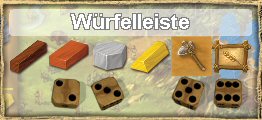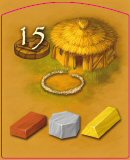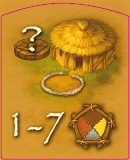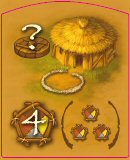StoneAge Zivilisations- und Gebäudekarten
Civilization cards
Each civilization map is divided into two areas: the lower part and the upper part. The upper part gives the player (usually immediately) a bonus.
Upper area

Victory points (3x): You get three win points immediately.

Raw material bonus (5x): You get the raw material

Raw material bonus cubes (3x): One dice with two cubes and immediately receives the corresponding number of raw materials analogously to the raw material fields. Unused tools may still be used.

Food bonus (7x): You get the number of food units immediately.

Card bonus (1x): You immediately get a hidden civilization card from the stack. The upper region of the card is not executed, it only counts the lower region for the final evaluation.

Food increase (2x): The food display is immediately increased by one.

One-time tool (3x): An additional tool is obtained which can be used once in the course of the game. After use it falls. The tool is displayed below the other tools and is offered automatically.

Permanent tool (1x): You immediately get a permanent tool that can be used like the tools from the toolmaker to the player.

Two raw materials (1x): Two raw materials are obtained. This card can be used immediately or later. For later use, it is "parked" below the food display. If you want to use them, click them and select the desired raw materials.

Dice bar (10x): All players benefit from this card. It is diced with as many dice as players participate. Then the dice results are assigned as follows: 1 -> wood, 2 -> clay, 3 -> stone, 4 -> gold, 5 -> tool, 6 -> food.

The active player may first select a bonus by clicking on it. After that all players follow reihum.
The lower area of civilization maps is available in two colors:
Green Civilization Cards








Each area (weaving, pottery, healing art, transport, music, astronomy, writing, art) is exactly twice.
Brown civilization maps
There are four categories:




There are seven peasants distributed on five cards (7/5), toolmakers (8/5), hut builders (9/5) and shamans (7/5).
Building maps
There are three different types of buildings:

In this type of building, you have to deliver exactly the raw materials listed below and get the number of points indicated above on the left. Here one would have to pay a brick, a stone and a gold and would receive 15 points.

In this type of building you can choose the type and number of raw materials. You simply pay 1-7 any raw materials (mixed) and get the number of valuable raw materials as a score. For example, if you would pay two wood, two stone and one gold, you would get 2x3 + 2x5 + 1x6 =22 points.

Here the number of raw materials is fixed (left), the number of different Raw materials are shown on the right in brackets. Here in the example, one would have to pay a total of four raw materials, of which three different types, for example two wood, a brick, a stone must be.

